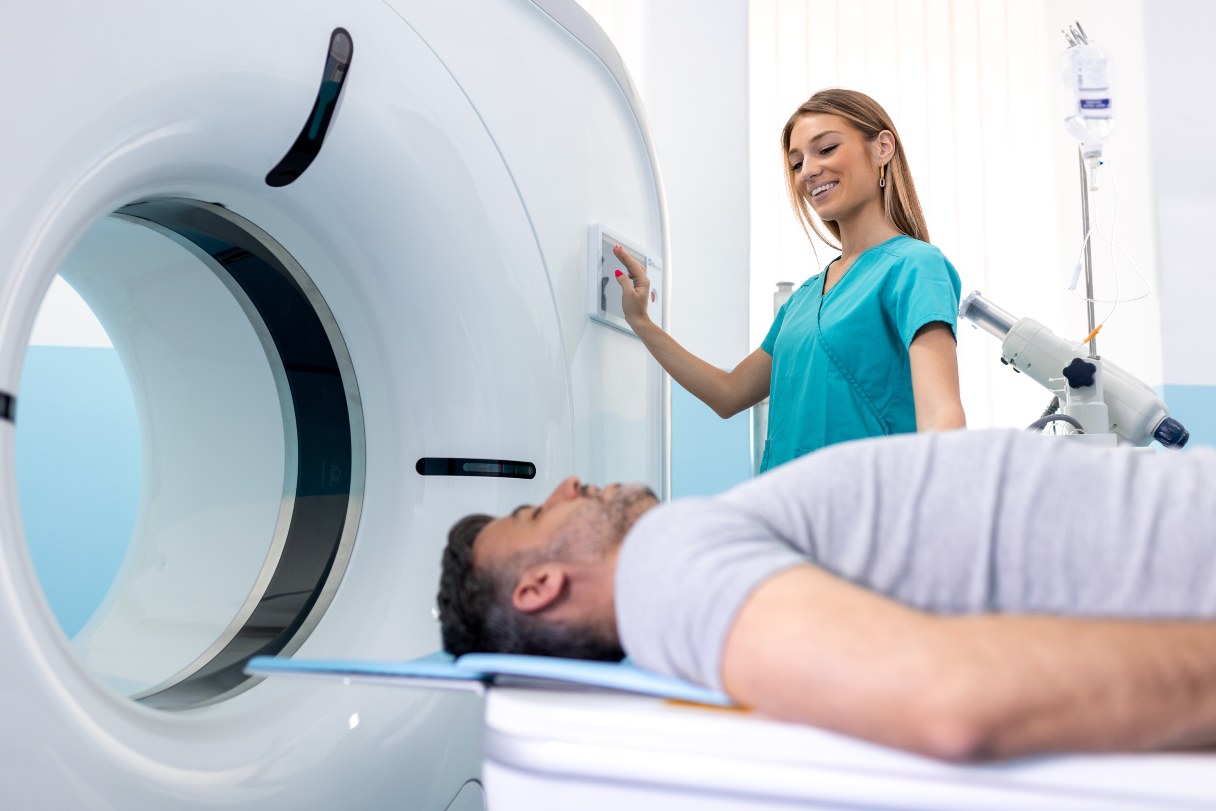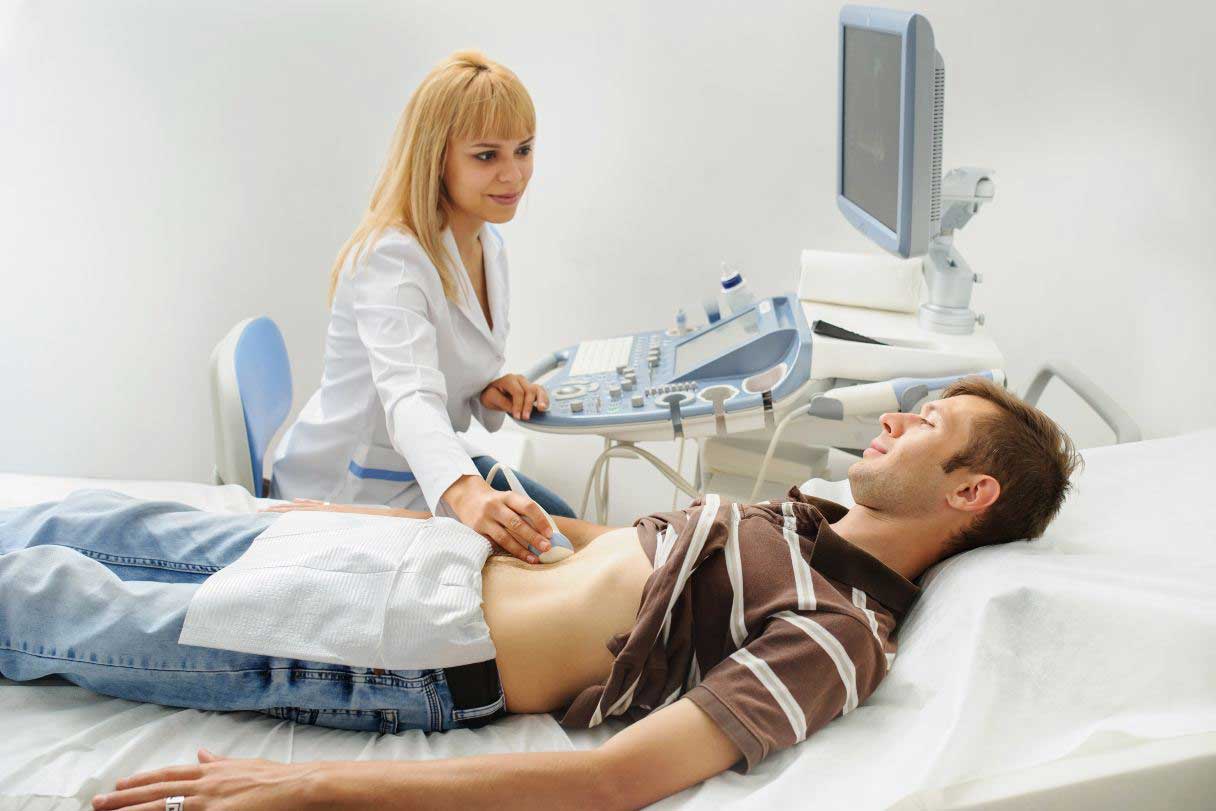Nearly 2 million positron emission tomography (PET) scans are performed every year in the United States. These imaging tests provide a safe and non-invasive way for your doctor to see what’s happening inside so they can make informed diagnoses.1
Here, we look at different types of PET scans, how to prepare for one and how much you can expect to pay.
What Is a PET Scan?
A PET scan is an imaging test that allows doctors to observe the metabolic activity of your cells to better diagnose a variety of potential medical issues, including:2
- Brain function after a traumatic injury, and to determine whether there is any bleeding or blood clots present in the brain
- How well your heart is functioning, and if it’s getting enough blood flow
- If cancer is present within your lungs
- If previously diagnosed cancer has spread to other parts of the body
- Neurological conditions such as Parkinson’s disease, Huntington’s disease, epilepsy and stroke
- The location of a surgical site prior to brain surgery
- Whether lesions or tumors are present within your lungs or other parts of the body
- Whether or not cancer treatment is working
Types of PET Scans
PET scans may involve a full-body or partial-body scan, depending on the information the doctor needs to make a diagnosis. Many PET scans are paired with a computed tomography (CT) scan in one machine called a PET/CT scanner. This gives your doctor a better view of possible sites affected by disease.2
PET scans come in various types, each targeting different areas and functions:
- Brain (neuro) PET scan. Evaluates various neurological conditions3
- Cardiac PET scan. Diagnoses cardiovascular disease and heart function3
- Cerianna (FES) PET scan. Uses fluoroestradiol F18 (FES), a radioactive hormone, to detect breast cancer cells in the body4
- Half-body (tumor-limited) PET scan. Focuses on part of the body, usually neck to pelvis, where tumors are likely to appear4
- Netspot PET scan. Uses the tracer GA-68 dotatate to detect neuroendocrine tumors4
- PET/CT scan. Combines PET and CT scans to show activity and structure in the body4
- PET/MRI scan. Combines PET and MRI scans to show activity and soft tissue4
- PSMA PET scan. Uses a prostate-specific membrane antigen (PSMA) to detect prostate cancer cells in the prostate and other parts of the body3
- Standard (FDG) PET scan. Uses fluorodeoxyglucose (FDG), a radioactive sugar, and CT imaging to look for cancer — one of the most common PET scans4
- Whole-body PET scan. Collects images from head to toe to check for cancer, infection or inflammation4
How Much Does a PET Scan Cost?
The national average cost* of PET scans ranges from $1,711 to $12,848, depending on the type of testing involved, whether it's performed as an inpatient or outpatient procedure and other factors.4
Here is a breakdown of the average cost* of different types of PET scans:4
Average PET scan cost by type
| Type | Average cost (inpatient) | Average cost (outpatient) |
|---|---|---|
| Brain (neuro) PET | $6,565 to $9,571, depending on tracer | $2,295 to $3,124, depending on tracer |
| Cardiac PET | $6,270 | $1,814 |
| Cerianna (FES) PET | $12,848 | $6,349 |
| Half-body (tumor-limited) PET | $5,789 | $1,711 |
| Netspot PET | $9,935 | $4,264 |
| PET/CT | $7,354 | $2,266 |
| PET/MRI | $12,809 | $5,844 |
| PSMA PET | $11,093 | $5,352 |
| Standard (FDG) PET | $5,608 | $1,901 |
| Whole-body PET | $7,313 | $2,517 |
What affects the cost of a PET scan?
The cost of your PET scan will vary based on several factors, including:4
- Equipment used
- Inpatient vs. outpatient
- Insurance coverage
- Length and complexity of the scan
- Office visits before and after
- Sedation, if needed
- Technician and radiologists fees
- Whether additional scans or other testing is needed
Is a PET scan covered by insurance?
A PET scan is covered by most health insurance companies as well as Medicare if your doctor deems it medically necessary.5 However, if your insurance company doesn’t cover the test, you may have to pay the full price yourself.6
Keep in mind that if your health insurance covers your test, you may still be responsible for paying a deductible and a coinsurance cost, which can vary. Check with your insurance provider to see what your out-of-pocket costs will come to.
How Is a PET Scan Different From Other Scans?
Imaging centers and hospitals may offer several types of internal scans, in addition to — and even combined with — PET scans. While all of these scans allow your doctor to visualize your internal organs and tissues, they do so in different ways and with various levels of detail.
CT vs. PET scan
A CT scan uses X-ray beams to create a three-dimensional image of the inside structures of your body, sometimes with contrast dye. A PET scan uses radioactive tracers and a special dye to scan for cancer or detect parts of your organs that aren’t functioning well on the cellular level.7
CT and PET technologies are often combined to give your doctor a more well-rounded and three-dimensional look at your body for a better diagnosis.2
MRI vs. PET scan
An MRI uses a strong magnet and radio waves to look at the inner structures of your body, especially soft tissue areas. It doesn’t use radiation of any kind and may involve the use of a contrast dye.7
While an MRI gives your doctor a good view of your organs and tissues, a PET scan examines the metabolic changes in your organs and tissues at a cellular level. This means that a PET scan can detect diseases at a much earlier stage.7
Many radiology centers combine the technology of an MRI with a PET scan to create a precise, three-dimensional image for your doctor to evaluate.7
Who Is a Good Candidate for a PET Scan?
Most people are good candidates for a PET scan. Your doctor will recommend a PET scan if they suspect you:2
- Have a cardiovascular or heart function issue
- Have a neurological condition or injury
- May have cancer, or your cancer has spread
You might not be a good candidate for a PET scan if you are:8
- Allergic to IV contrast dye or the ingredients of the tracer
- Claustrophobic
- Diabetic
- Have a glucose monitor
- Over 500 pounds
- Pregnant or nursing
- Unable to lie on your back for 15 to 45 minutes
How Does a PET Scan Work?
A PET scan is an outpatient procedure that is non-invasive and takes place inside a donut-shaped machine. You’ll have to prepare for the test to ensure the best possible images for your doctor to use to make a diagnosis.3
Preparation
You will be instructed to:10
- Avoid exercising for 24 to 48 hours before your scan.
- Be sure to eliminate sugar and carbohydrates — bread, cereal, desserts, fruits, pasta, starchy vegetables — from your diet for 24 hours before your test.
- Eat only proteins and non-starchy vegetables, such as meat, fish, poultry, spinach and kale, for 24 hours before your test.
- If you’re diabetic, stop insulin administration four hours prior to the test.8
- Refrain from eating six hours or less before your test, limiting your intake to only water during that six-hour fasting period.
Procedure
When you arrive at the radiology center, you’ll be asked to change into a hospital gown, remove your jewelry and empty your bladder.2 Then, about an hour before the scan, you’ll be given an IV injection with the radioactive tracer in your arm or hand.3 The tracer, most commonly made up of glucose or water and combined with radioactive material, is metabolized by the organs being investigated.9
You’ll sit and relax, giving your body a chance to absorb the tracer. Afterward, you’ll lie down with your arms positioned above your head on a narrow table before a radiology technician slides you into the PET scan machine.3
The PET scan itself usually takes between 15 minutes to one hour, depending on your medical condition and the parts of your body being scanned.3 During this painless test, you must lie as still as possible; the tech will ask you to hold your breath for short periods of time.3
Depending on the type of scan, you may also be given an oral contrast solution to drink.3 Additionally, for some types of PET/CT scans of the abdomen or pelvis, your technician may insert a catheter for the duration of the test.2
Recovery
If your PET scan is an outpatient procedure, you’ll go home right after the test. You can return to your normal activities immediately.10
You can also take a few precautions to speed up your recovery and protect your loved ones:
- Avoid contact with pregnant people and children for 12 hours after the test.10
- Call your doctor if you experience nasal congestion, itchy eyes, tremors, pain, nausea or vomiting, which could indicate an allergic reaction.11
- Drink plenty of water and other liquids to help flush out the radioactive tracer, which should pass through your system completely within two days.10
- Don’t breastfeed until 24 hours after the exam.9
A specialist will review your PET scan and share the results with your doctor.8
Is a PET Scan Safe?
While a PET scan does expose you to some radiation, the amount is very low, and the radioactive tracer passes through your body within a few hours. This makes PET scans a safe diagnostic procedure.9
If you’ve been told that you need a PET scan to assess your health, there’s no need to worry. You’ll be assisted throughout the preparation and testing procedure. A PET scan can help your healthcare provider make a proper diagnosis so you can get the care you may need.
Managing Health and Wellness Costs With the CareCredit Credit Card
If you are looking for an option to help manage your health and wellness costs, consider financing with the CareCredit credit card. The CareCredit credit card can help you pay for the care you want and need and make payments easy to manage.** Use our Acceptance Locator to find a provider near you that accepts CareCredit. Continue your wellness journey by downloading the CareCredit Mobile App to manage your account, find a provider on the go and easily access the Well U blog for more great articles, podcasts and videos.
Your CareCredit credit card can be used in so many ways within the CareCredit network including vision, dentistry, cosmetic, pet care, hearing, health systems, dermatology, pharmacy purchases and spa treatments. How will you invest in your health and wellness next?
Author Bio
Susan Paretts is a freelance writer with 20 years of experience covering health and wellness, pet care and more. Her work has been published by the American Kennel Club, Bayer Animal Health, Elanco, LIVESTRONG.com, The San Francisco Chronicle, Chewy and more.








